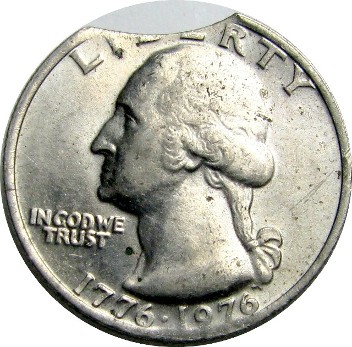Part V. Planchet Errors:
Blanking and Cutting Errors:
Curved clips
Definition: A curved clip is generated when a punch (blanking die) overlaps a previously-punched hole in the coin metal strip. The resulting blank ends up with a concave deficit. It is believed that a failure for the coin metal strip to advance properly through the blanking press is the root cause of this planchet error.
Multiple curved clips and overlapping curved clips do occur.
Some prefer the term “incomplete planchet” for this error, but we do not. “Incomplete planchet” is non-specific and awkward to use. Saying that a coin was struck on a “curved incomplete planchet” or a “double curved incomplete planchet” creates more headaches than it solves.
Five diagnostics for genuine curved clips are:
1. The pole opposite the clip often shows a weak or absent rim. This is the “Blakesley” effect.
Special Note: The “Blakesley” effect is not always seen on coins with authentic curved clips which are LARGE.
2. Design elements bordering the clip often show metal flow — a smearing and stretching out of the design.
3. The exposed edge of the clip will usually show a “belly line” or “breakaway zone”. Half of the exposed edge (upper or lower half) will be grainy and the other half smooth.
4. The rim should fade out and taper toward the clip.
5. Reversal of position of exposed copper core. This pertains only to curved and elliptical clips in clad issues. In a clad coin, the copper core is asymmetrically exposed along the edge. The position of the exposed copper core “flips” when you transition from a normal edge to the clipped edge. The reason is simple: the normal edge represents the edge of the blank, while the clipped edge represents the edge of the hole.
For expanded treatment concerning clip diagnostics click here.
Below is a bicentennial quarter. This specimen displays all five diagnostics for an authentic curved clip on a clad coin. Note the position of the exposed copper core along the edge. The center image illustrates how the core position “flips” from a normal edge and transitions to the clipped edge.


